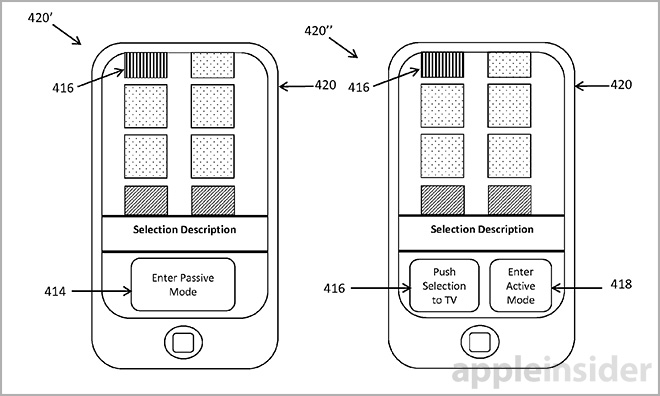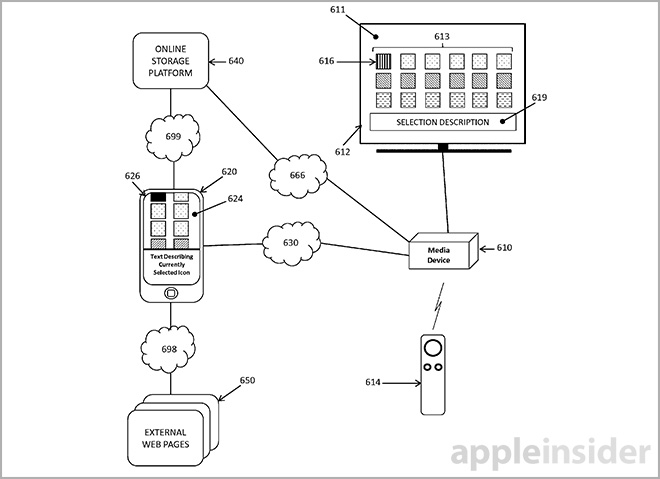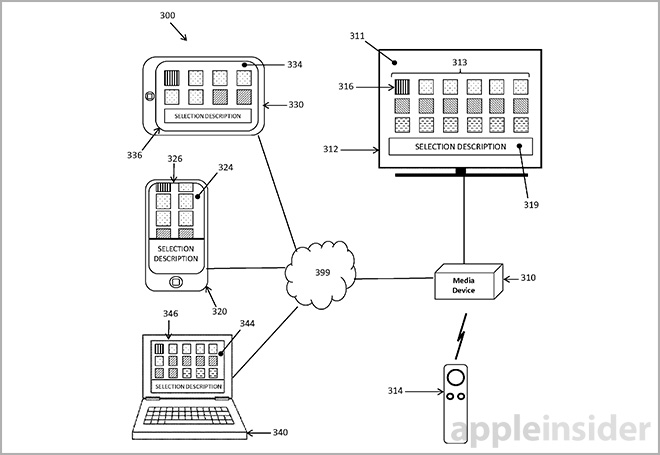Apple's next-gen iOS Remote app solution could boast full Apple TV GUIs, interactive content
Last updated
An Apple patent application published Thursday describes a next-generation iOS Remote app system capable of translating the Apple TV's UI to smaller format iPhone and iPad screens, while streaming back external content like movie trivia from those same devices.
As filed with the U.S. Patent and Trademark Office, Apple's patent application for "Browsing remote content using a native user interface" details what amounts to an advanced Apple TV remote control app that interprets media content and semantic information to reproduce a graphical user interface native to an iPhone or iPad display.
Unlike Apple's current Remote app, which employs a bespoke UI tailored specifically for the iPhone or iPad, the proposed iteration would dynamically "size down" an Apple TV's GUI based on semantic cues sent to the client device from a source Apple TV or Mac running iTunes. Using this method allows for a much richer user experience that moves beyond the existing digital reproduction of remote control hardware.
For example, the app can display a full Apple TV interface — or icon matrix — remotely, including media descriptions, posters, ratings, purchasing options and more.
Code for interpreting semantics information sent out by the host device can be kept on board a client iPhone, or the programming can be tapped from an off-site server like iCloud. Keeping semantics translation instructions in the cloud allows for greater flexibility with older devices not usually supported by a modern app.
Apple outlines two possible embodiments for the remote app, one active and one passive. With the active version, users interact with an Apple TV or other host device in real time, meaning any selections made on the iOS device are immediately be reflected on the larger television screen.
Most of the document deals with the above described active mode, though mention is made of passive operation in which a client device stores user input, then pushes that data to the host device when instructed to do so. Passive mode can, for instance, let one user browse through a host's media catalog without disturbing other viewers.
This method is also a starting point for streaming media from an iOS device to a host Apple TV, a capability already offered with AirPlay.
One of the more substantial features involves outside content gathered to augment media being played or streamed by the host Apple TV. For example, a user may start a movie via the iOS device, then leave the remote app to search for trivia on the Web. Any information discovered outside the remote control app can then be sent back to the host device for display, whether it be an overlay, sidebar or other means of presentation.
In addition to the operational enhancements, Apple also notes client devices can be paired with an Apple TV via proximity sensor technology, suggesting support for iBeacon. Since Apple TV software update version 6.1 launched in March, the set-top streamer has been able to scan for compatible devices over Bluetooth.
Apple's patent application for a next-generation remote app was first filed for in March 2013 and credits Thomas Alsina, Lucas C. Newman and Nicholas James Paulson as its inventors.
 Mikey Campbell
Mikey Campbell
















 Amber Neely
Amber Neely
 Thomas Sibilly
Thomas Sibilly
 AppleInsider Staff
AppleInsider Staff
 William Gallagher
William Gallagher
 Malcolm Owen
Malcolm Owen
 Christine McKee
Christine McKee










21 Comments
Good. Current remote sucks. Hard to use, difficult to accurately select menu options. I always overshoot and end up going back to the main screen.
Hopefully this will help them unlock the thing for many different streaming apps, I stay with my Roku until they unlock it for other channels.
[quote name="SDW2001" url="/t/182633/apples-next-gen-ios-remote-app-solution-could-boast-full-apple-tv-guis-interactive-content#post_2611562"]Good. Current remote sucks. Hard to use, difficult to accurately select menu options. I always overshoot and end up going back to the main screen.[/quote] I agree. This would be great!
Hopefully this will help them unlock the thing for many different streaming apps, I stay with my Roku until they unlock it for other channels.
What specifically is AppleTV missing that you have on Roku? Legitimately curious.
Good. Current remote sucks. Hard to use, difficult to accurately select menu options. I always overshoot and end up going back to the main screen.
That's a bit harsh, its better than anything else out there.
But the Remote App is indeed long overdue for an overhaul and dramatic improvement. It is a bit slow and clunky. The idea of beaming the AppleTV UI directly to the iPad/iPhone and letting you manipulate the UI from there is brilliant, and will make it far more enjoyable.
I think this is in part the "cracking it" that Steve referred to years ago....the very idea of the TV's actual UI beaming itself to your handheld in much more manipulative and interactive way, result in content played back on the screen (likely combined with some dual screen modes/features as well) would be brilliant.
This is also 10,000x better than talking to your TV.
No matter what they do, they desperately NEED to figure out Global Search on AppleTV. I should be able to type in the name of a movie or tv show and get a list of search results with every onboard App that has it.
I'm not seeing a significant departure from Netflix or YouTube with Chromecast. Is this patentable?